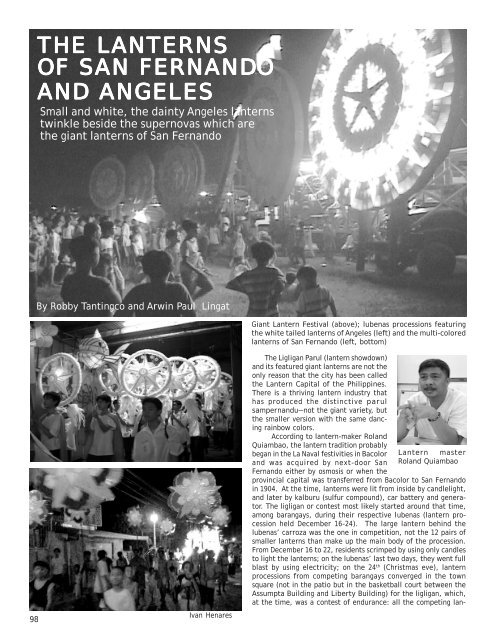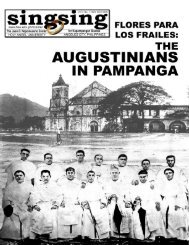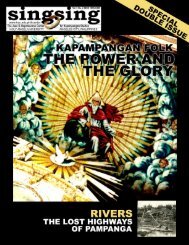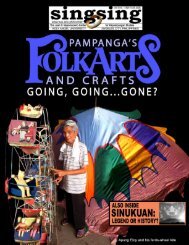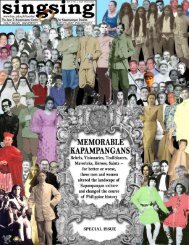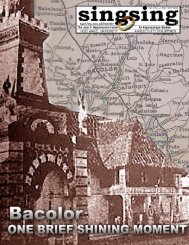Download PDF - Holy Angel University
Download PDF - Holy Angel University
Download PDF - Holy Angel University
Create successful ePaper yourself
Turn your PDF publications into a flip-book with our unique Google optimized e-Paper software.
98<br />
THE THE LANTERNS<br />
LANTERNS<br />
OF OF SAN SAN FERN FERNANDO<br />
FERN ANDO<br />
AND AND ANGELES<br />
ANGELES<br />
Small and white, the dainty <strong>Angel</strong>es lanterns<br />
twinkle beside the supernovas which are<br />
the giant lanterns of San Fernando<br />
By Robby Tantingco and Arwin Paul Lingat<br />
Ivan Henares<br />
Giant Lantern Festival (above); lubenas processions featuring<br />
the white tailed lanterns of <strong>Angel</strong>es (left) and the multi-colored<br />
lanterns of San Fernando (left, bottom)<br />
The Ligligan Parul (lantern showdown)<br />
and its featured giant lanterns are not the<br />
only reason that the city has been called<br />
the Lantern Capital of the Philippines.<br />
There is a thriving lantern industry that<br />
has produced the distinctive parul<br />
sampernandu—not the giant variety, but<br />
the smaller version with the same dancing<br />
rainbow colors.<br />
According to lantern-maker Roland<br />
Quiambao, the lantern tradition probably<br />
began in the La Naval festivities in Bacolor<br />
and was acquired by next-door San<br />
Fernando either by osmosis or when the<br />
Lantern master<br />
Roland Quiambao<br />
provincial capital was transferred from Bacolor to San Fernando<br />
in 1904. At the time, lanterns were lit from inside by candlelight,<br />
and later by kalburu (sulfur compound), car battery and generator.<br />
The ligligan or contest most likely started around that time,<br />
among barangays, during their respective lubenas (lantern procession<br />
held December 16-24). The large lantern behind the<br />
lubenas’ carroza was the one in competition, not the 12 pairs of<br />
smaller lanterns than make up the main body of the procession.<br />
From December 16 to 22, residents scrimped by using only candles<br />
to light the lanterns; on the lubenas’ last two days, they went full<br />
blast by using electricity; on the 24 th (Christmas eve), lantern<br />
processions from competing barangays converged in the town<br />
square (not in the patio but in the basketball court between the<br />
Assumpta Building and Liberty Building) for the ligligan, which,<br />
at the time, was a contest of endurance: all the competing lan-


